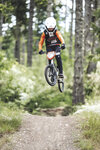

For many middle schoolers, hopping on a bike during the summer months means goofing around with friends or riding around the neighborhood streets.
For 12-year-old Caleb Durkin, going for a bike ride has a whole different meaning.
Durkin is one of the top amateur BMX riders in the country.
BMX — which stands for Bicycle Motocross — is a style of bike made for off-road competitions and even trick riding. For the races Durkin competes in, it’s less about tricks and more of a focus on speed and agility.
Races are done on indoor or outdoor dirt tracks consisting of flat areas, obstacles, jumps and large banked corners helping racers keep speeds around 30 miles per hour. Adding to the challenge is that racers are normally side-by-side within inches of each other. That means if you fall behind, or just plain fall, you likely stay behind. It’s 30 seconds of nonstop intensity.
Durkin picked up the sport when he was 2 years old. His dad, Cory, would take Caleb to watch some of Cory’s friends race at nearby tracks. Cory, himself, is an accomplished motorcycle motocross racer, so Caleb had his choice of a bike with or without an engine.
“I have a dirt bike, but I’m happier on a non-motorized bike,” Caleb said. His mom, Alissa, agreed.
“What I like is he has more control of his bicycle,” she said, adding that Cory has broken his ankle and collar bone during races. But Caleb, knock on wood, has only suffered scratches and bruises in his 10 years of bike riding.
Besides the national races, Caleb spends almost every weekend competing locally.
Racers need to be in tip-top shape to control their bodies to control their bikes. In addition to training on a track twice a week in SeaTac, his workout routine includes lots of leg and ab training. He also puts his bike on rollers, which essentially makes it a stationary bike, where he can practice doing 15-second sprints, 15 to 20 times, while indoors.
Caleb, who turns 13 in August and will be an eighth grader at Key Peninsula Middle School in September, said BMX racing is a unique sport that even his classmates don’t know much about. About once a month during the school year, the Durkins head out of state for most national races, so Caleb has to keep up with homework while on the road. BMX racing has recently taken the family to such places like Virginia, Florida, North Carolina, and even Canada. A typical race week means leaving on a Wednesday and getting some practice in on the track on Thursday, with races Friday through Sunday. They come home on Monday. The two parents have their roles on the trip: Cory is more of the technical coach and Alissa provides the motivation and emotional support.
“It’s an exhausting week,” Alissa said. “He can be on point and (because of how packed the track is) the smallest, slightest mistake by him or another racer can wipe out an entire weekend of racing.”
Riders compete at national events from Jan. 1 to Dec. 15 each year to earn points. According to USA BMX, the rider’s bike number (called a National Age Group, or NAG, plate) changes based on their ranking in points. Caleb is currently sitting as NAG 2, meaning he ranks No. 2 in the country in his age group with six wins this season. As of June 20, he has the 32nd most points for any age group.
If Caleb picks up two wins in Reno this month, he could move to NAG 1. That ranking matters come Thanksgiving weekend every year when “The Greatest Race on Earth” takes place in Tulsa, Oklahoma. Known formally as the Grand Nationals, the race features the best BMX riders in the world and determines final rankings each year. This is Cory’s third Grand Nationals.
As in most sports, the better you are, the more recognition you get. Caleb was invited to join a factory-sponsored team four years ago and being part of that helps pay for some of his racing fees, along with getting his bike and equipment paid for. The owner of his factory team is Donovan Long, the father of two-time BMX Olympian Nic Long.
“There’s always things to work on, no matter your skill or age,” Caleb said. “How can I get over this jump faster? How can I be faster out of the corner or in the straightaway?”
He continues to hone his skill to meet his ultimate goal of turning professional, which he can do when he’s 16. He’d also like to be competing for a spot on the 2028 Summer Olympics team.
“He loves the challenge of it. In the end, it’s really whatever his aspirations are,” Alissa said. “We’re here to support him. At any moment if he says he is burnt out and done, that’s OK with us. We’ll go as long as he says he wants to keep going.”
UNDERWRITTEN BY THE FUND FOR NONPROFIT NEWS (NEWSMATCH) AT THE MIAMI FOUNDATION, THE ANGEL GUILD, ADVERTISERS, DONORS AND PEOPLE WHO SUPPORT INDEPENDENT, NONPROFIT LOCAL NEWS